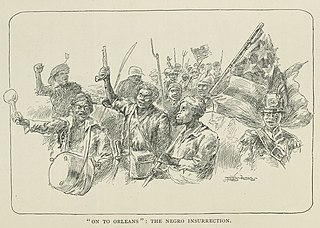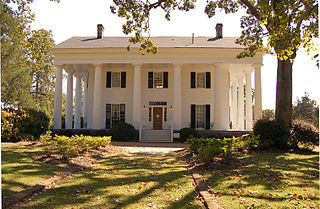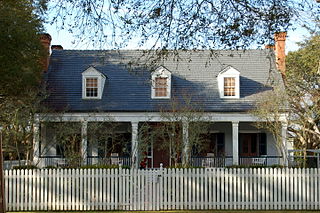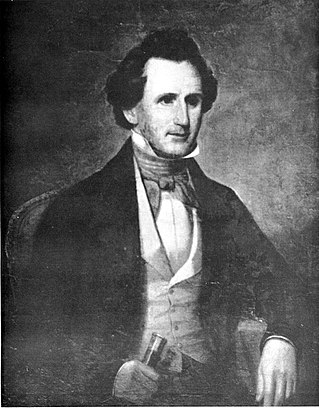
The Garden District is a neighborhood of the city of New Orleans, Louisiana, United States. A subdistrict of the Central City/Garden District Area, its boundaries as defined by the New Orleans City Planning Commission are: St. Charles Avenue to the north, 1st Street to the east, Magazine Street to the south, and Toledano Street to the west. The National Historic Landmark district extends a little farther.

Oak Alley Plantation is a historic plantation located on the west bank of the Mississippi River, in the community of Vacherie, St. James Parish, Louisiana, U.S. Oak Alley is named for its distinguishing visual feature, an alley or canopied path, created by a double row of southern live oak trees about 800 feet long, planted in the early 18th century — long before the present house was built. The allée or tree avenue runs between the home and the River. The property was designated a National Historic Landmark for its architecture and landscaping, and for the agricultural innovation of grafting pecan trees, performed there in 1846–47 by a gardener.

Jean-Noël Destréhan de Tours was a Creole politician in Louisiana and one-time owner of St. Charles Parish's Destrehan Plantation, one of Louisiana's historic antebellum landmarks. The community of Destrehan was named for his family.

Destrehan Plantation is an antebellum mansion, in the French Colonial style, modified with Greek Revival architectural elements. It is located in southeast Louisiana, near the town of the same name, Destrehan.

Wade Hampton was an American soldier and politician. A two-term U.S. congressman, he may have been the wealthiest planter, and one of the largest slave holders in the United States, at the time of his death.

Andrew Beirne was an Irish immigrant who became a merchant, militia officer and politician in western Virginia, representing Monroe County in both houses of the Virginia General Assembly as well as the United States House of Representatives and the Virginia Constitutional Convention of 1829-1830.

The Magnolia Mound Plantation House is a French Creole house constructed in 1791 near the Mississippi River in Baton Rouge, Louisiana. Many period documents refer to the plantation as Mount Magnolia. The house and several original outbuildings on the grounds of Magnolia Mound Plantation are examples of the vernacular architectural influences of early settlers from France and the West Indies. The complex is owned by the city of Baton Rouge and maintained by its Recreation Commission (BREC). It is located approximately one mile south of downtown.

Belmont Mansion, also known as Acklen Hall, and originally known as Belle Monte, Belle Mont or Belmont, is a historic mansion located in Nashville, Tennessee. It was built by Joseph and Adelicia Acklen to serve as the center of their 180-acre summer estate in what was then country outside the city, and featured elaborate gardens and a zoo. They lived much of the rest of the year on her plantations in Louisiana.

Nottoway Plantation, also known as Nottoway Plantation House is located near White Castle, Louisiana, United States. The plantation house is a Greek Revival- and Italianate-styled mansion built by slaves and artisans for John Hampden Randolph in 1859, and is the largest extant antebellum plantation house in the South with 53,000 square feet (4,900 m2) of floor space.

The Hampton–Preston House located at 1615 Blanding Street in Columbia, South Carolina, is a historic mansion that was the home of members of the prominent Hampton family. It was listed in the National Register of Historic Places on July 29, 1969.

John Smith Preston was a wealthy planter, soldier, and attorney who became prominent in South Carolina politics in the 19th century. An ardent secessionist, he was the state's delegate dispatched to help convince the Virginia Secession Convention to join South Carolina in seceding from the antebellum Union in the months prior to the start of the American Civil War.
Burnside is an unincorporated community in Ascension Parish, Louisiana, United States. It was founded by French and German settlers in 1726, early in the French colonial period. The ZIP Code for Burnside is 70738.

The 1811 German Coast uprising was a revolt of slaves in parts of the Territory of Orleans on January 8–10, 1811. The uprising occurred on the east bank of the Mississippi River in what is now St. John the Baptist, St. Charles and Jefferson Parishes, Louisiana. The slave insurgency was the largest in U.S. history, but the rebels killed only two White men. Confrontations with militia, combined with post-trial executions, resulted in the deaths of 95 slaves.

Ashland Plantation, also known as the Belle Helene or Ashland-Belle Helene Plantation, is a historic building, built in 1841, that was a plantation estate and home of Duncan Farrar Kenner. Located in Darrow, Louisiana, in Ascension Parish. The manor house is an example of antebellum Greek Revival architecture.

Antebellum architecture is the neoclassical architectural style characteristic of the 19th-century Southern United States, especially the Deep South, from after the birth of the United States with the American Revolution, to the start of the American Civil War. Antebellum architecture is especially characterized by Georgian, Neo-classical, and Greek Revival style homes and mansions. These plantation houses were built in the southern American states during roughly the thirty years before the American Civil War; approximately between the 1830s to 1860s.

Plantation complexes were common on agricultural plantations in the Southern United States from the 17th into the 20th century. The complex included everything from the main residence down to the pens for livestock. Until the abolition of slavery, such plantations were generally self-sufficient settlements that relied on the forced labor of enslaved people.

The LaBranche Plantation Dependency House is located in St. Rose, St. Charles Parish, Louisiana. From many accounts, LaBranche Plantation in St. Rose, Louisiana, was one of the grandest on the German Coast until it was destroyed during the Civil War. All that remained was the dependency house, known as a garconnière.
Oliver Beirne was a landowner from western Virginia, one of the owner of the Old Sweet Springs resort, and sole heir to plantation millionaire John Burnside, of whom he was a longtime friend.

The Orange Grove Plantation House is a historic house on a former plantation in Terrebonne Parish, about eight miles away from Houma, Louisiana. It was built in 1850 for John C. Beatty, a sugar planter who owned slaves. The plantation spanned 2,470 acres of land when it was sold at auction shortly after Beatty's death in 1857. Beatty's slaves were sold with the property.

Robert Ruffin Barrow was one of the largest landowners and slave owner in the south before the American Civil War. He owned sixteen plantations, mostly in Louisiana, and had large landholdings in Texas. He also invested money in projects in which he saw potential. The most well known investment he made was in the early submarine projects of his brother-in-law, Horace Hunley, for the Confederate States Navy.

























